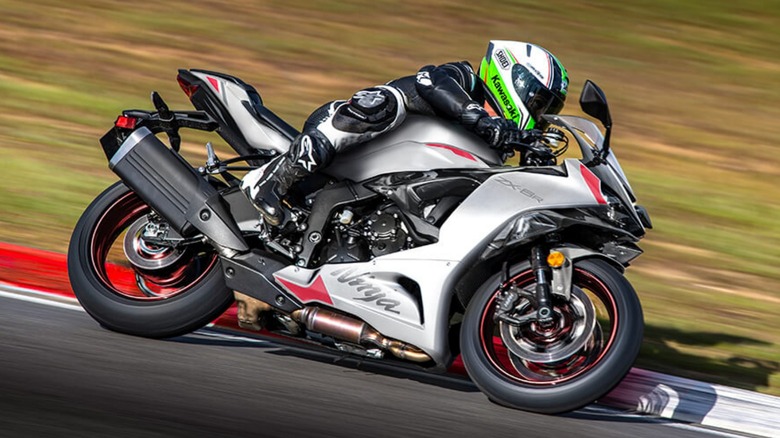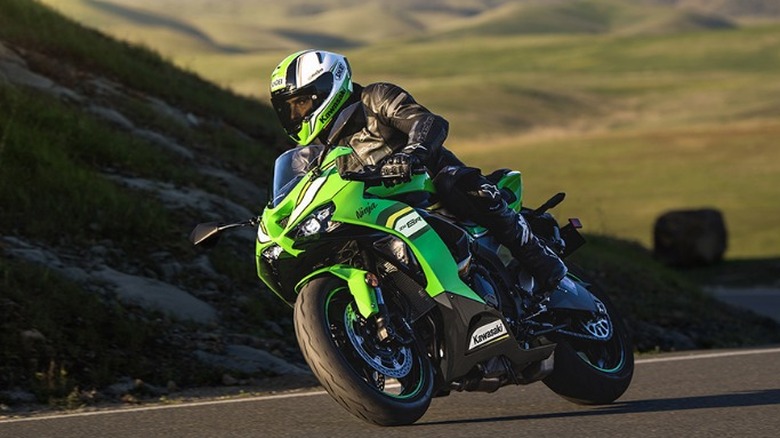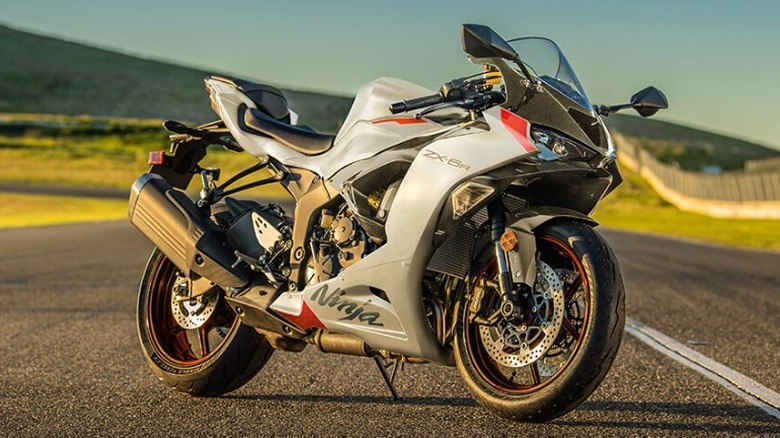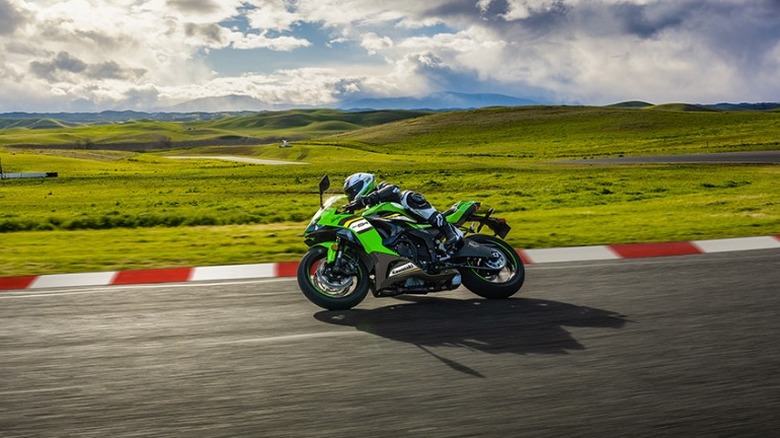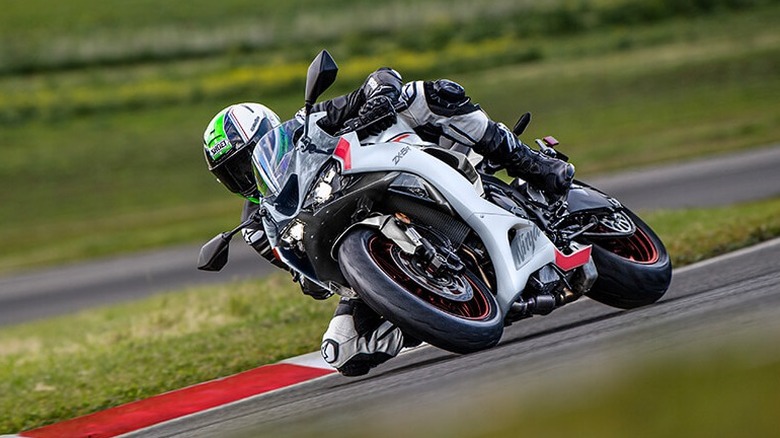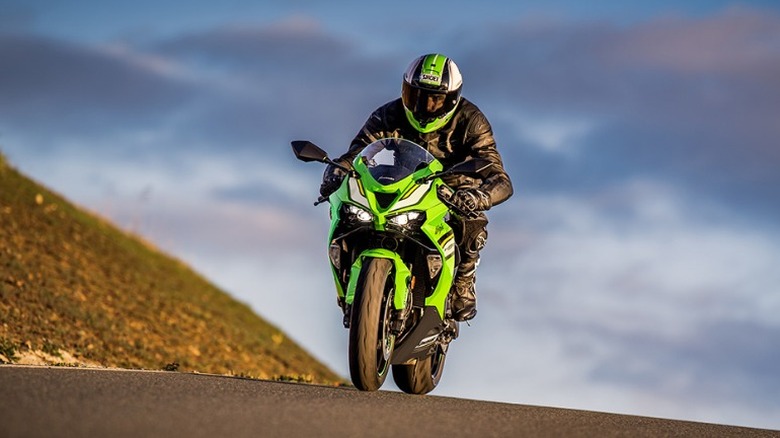5 Reasons Why Kawasaki's Ninja ZX-6R Is Such An Expensive Motorcycle
Kawasaki is one of the best major motorcycle brands on the market. Its astronomic rise in popularity over the years can be attributed, in no small part, to its line of Ninja sport bikes. The company offers a wide range of different models in this category, with a catalog of 13 bikes that dwarfs the much more modest selection of options from most competitors. Even Honda and Yamaha only offer five to six street bikes apiece. What's more, several of these performance-hungry motorcycles are among the most powerful and reliable street-ready sport bikes on the road today. The Ninja ZX-6R is a sterling example. This midsized street bike might be smaller and lighter than some of its larger cousins, but it's a powerful representation of Kawasaki's engineering.
Some who look at the ZX-6R's price tag might question what it is about the bike that makes it come at such a high cost, however. The 2024 Kawasaki ZX-6R currently retails for $11,399, making it significantly more expensive than the similarly-sized Ninja 650 and other bikes like the Honda CBR650R. It's even a bit more expensive than some larger bikes, such as the Yamaha YZF-R7 and the Suzuki GSX-8R. So what is it about the ZX-6R that has led Kawasaki, a typically affordable brand, to put such a big price tag on it?
The ZX-6R is a Supersport
There are a lot of different sports bikes in the world, so which bikes do and don't qualify to fit in the category can be difficult to define in some cases. The term has several connotations and there is a fair bit of variety across the spectrum. Most have an aerodynamic design and favor speed and handling over efficiency and comfort, but there are also street bikes that are definitely more at home on urban roads while others are better suited to the racetrack. Some also have additional features and upgraded components that significantly raise their MSRP. Kawasaki sought to break its bikes up into more clearly defined terms by creating three sub-categories: Sport, Supersport, and Hypersport.
The basic Kawasaki sport bikes are engineered for affordability and easy road travel. They're still plenty fast, but they're designed to be entry-level machines that are approachable. Those bikes with the "ZX" designation, such as the ZX-6R, fall into the Supersport category. These are even more performance-oriented than the regular Ninjas. They have specially tuned engines, upgraded secondary components, special features, and stylistic elements that all make them a cut above the ordinary.
Consequently, this also means that they tend to be more expensive. The Ninja ZX-4R is more expensive than the larger Ninja 500, the ZX-6R is more expensive than the Ninja 650, and the ZX-10R is more expensive than the Ninja 1000SX. The only Kawasaki sport bikes that come at a higher cost than the ZXs are the 998cc supercharged Ninja H2 Hypersport models. That said, the ZX-6R is competitively priced when compared to similarly sized Supersport bikes from other brands, such as the Honda CBR600RR.
The ZX-6R has a powerful engine
To understand what makes the ZX-6R is as pricey as it is, we first need to take a look at its most important component: the engine. Beneath its fairings, the ZX-6R is powered by a 636cc DOHC, four-stroke, in-line four-cylinder, 16-valve, liquid-cooled engine. It has a 67.0-millimeter bore, a 45.1-millimeter stroke, and a 12.9:1 compression ratio. It uses a DFI fuel system with 38-millimeter Keihin throttle bodies and oval sub-throttles, a TCBI ignition with electronic advance, a six-speed transmission with return shift functionality, and a sealed drive chain.
This is technically a slightly smaller displacement than the 649cc engines that can be found in the cheaper Ninja 650 and Honda CBR650R, but don't let that fool you. The ZX-6R's engine is able to generate up to 127 horsepower at 13,000 RPM and can produce up to 52.1 lb-ft of torque at 10,800 RPM. This marks a considerable step-up in power when compared to its larger cousins.
Part of how it achieves this is by using dual throttle valves. "On models with dual throttle valves, there are two throttle valves per cylinder: in addition to the main valves, which are physically linked to the throttle grip and controlled by the rider, a second set of valves, opened and closed by the ECU, precisely regulates intake airflow to ensure a natural, linear response," says Kawasaki. "With the air passing through the throttle bodies becoming smoother, combustion efficiency [is] improved and power is increased." This gives the ZX-6R a significant boost over bikes that simply use large-bore throttle bodies.
The ZX-6R uses upgraded components
It isn't just the engine that gets an upgrade, though. Other components in the ZX-6R are a bit more advanced than the stock alternatives found in most of the basic Ninja line as well. To start, the front suspension is composed of a 41-millimeter inverted Showa Separate Function Big Piston Fork which is designed for racing. It comes with rebound and compression damping for those times when the road isn't quite as smooth as you'd like, spring preload adjustability, so you can customize the shock absorption to the weight and preferences of the rider, and top out springs. In the back, it has a Bottom-link Uni-Trak single shock which also comes with stepless compression damping adjustment, stepless adjustable rebound damping, and fully adjustable spring preload. This upgraded suspension alone accounts for much of the price disparity between the supersport and regular Ninja motorcycles.
Then there are the brakes to consider. The ZX-6R uses the same single 220-millimeter petal discs and single-piston caliper as the Ninja 650 in the rear, but the front brake uses upgraded dual radial-mounted semi-floating 310-millimeter discs and opposed four-piston caliper. Additionally, both the front and rear brakes include Kawasaki's Intelligent anti-lock Brake System (KIBS) if you spring for the ABS model. Of course, high-end components demand a high-end price.
The ZX-6R's performance is top tier
Specifications are all well and good, but they don't amount to much if they don't translate into raw performance. Fortunately, in the case of the ZX-6R, they do. This bike is the second fastest 600cc motorcycle ever made by top speed.
Take one look at the bike's top speed and acceleration times, and you'll start to understand why Kawasaki feels that it can charge a bit more for it. The aforementioned high horsepower and torque make it so that the bike can go from 0-60 MPH in just three seconds, so it clearly has plenty of pep. This bike isn't just hot off the starting line though, it can get all the way up to 164 mph before topping out, meaning that it comes in just behind the marginally larger Triumph Daytona 675 R which inches past it with its top speed of 165 mph.
The bike handles tight turns and corners well, too. According to testing performed by Cycle World that pitted the bike against a Suzuki GSX-R600, "the ZX-6R's added midrange made it easy to pull away from the Suzuki through a series of tight corners. The benefits are more than just in time and space, however, as the 6R's beefier midrange allows the Kawasaki-mounted rider to be more relaxed. There's a broader trigger, and it's easier to pull. That requires less focus." So not only does it boast superior performance, but Cycle World found that it's easier to ride as well.
The ZX-6R has several additional features
Another aspect that contributes to the expense of the Ninja ZX-6R is its added technological features. We've already gone over its optional intelligent ABS system, but there are several other features that help set it apart. It has Kawasaki Traction Control (KTRC) which helps the bike maintain contact with the road by allowing the rider to choose from a number of selectable modes. These modes are numbered, with the lower number emphasizing maximum acceleration, while the higher numbers emphasize riding stability. It has the Kawasaki Quick Shifter, which allows for clutchless upshifting while keeping the throttle fully open in order to streamline acceleration. It also has an assist and slipper clutch, an economical riding indicator, and smartphone connectivity features.
But one of the more striking features that the bike offers is that it also has two different power modes. One limits the bike's maximum power and throttle response to make it more comfortable for road riding, while the other allows the rider to exploit the full potential of the bike's engine. This is great for riders who prefer a more mellow ride for their daily commute, but want to be able to open up the full capabilities of a performance motorcycle at the track on the weekends. Few of these features are standard on entry-level 600cc bikes, so it makes sense that Kawasaki would charge more for including them.
